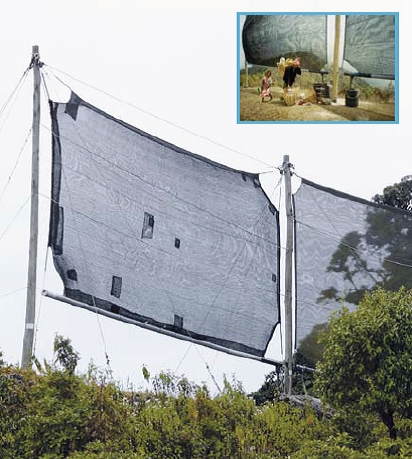Difference between revisions of "Water Portal / Rainwater Harvesting / Fog and dew collection / Fog collection and storage"
(→Technical specification) |
|||
| Line 29: | Line 29: | ||
Efficiency of collection improves with larger fog droplets, higher wind speeds, and narrower collection fibers / mesh width. In addition, the mesh should have good drainage characteristics. | Efficiency of collection improves with larger fog droplets, higher wind speeds, and narrower collection fibers / mesh width. In addition, the mesh should have good drainage characteristics. | ||
| − | |||
| − | |||
====Maintenance==== | ====Maintenance==== | ||
A polypropylene mesh has a lifetime of about ten years. In Nepal, operation and maintenance is difficult due to the unavailability of spare parts (mainly polypropylene mesh). Hence keeping stock of mesh and other spare parts is highly recommended. | A polypropylene mesh has a lifetime of about ten years. In Nepal, operation and maintenance is difficult due to the unavailability of spare parts (mainly polypropylene mesh). Hence keeping stock of mesh and other spare parts is highly recommended. | ||
| − | |||
| − | |||
==Cost== | ==Cost== | ||
Revision as of 02:05, 23 March 2012
| |
Fog water collection uses large polypropylene mesh nets on ridges to capture water-loaded fog, which forms in humid months in mountainous regions or coastal areas. The meshes are erected perpendicular to the prevailing wind. The mesh captures small water droplets (1 to 40 μm), which trickle into a collection trough or gutter and drain into a series of tanks. Trees and grass intercept fog in a similar way.
Intercepted fog is commonly of a good quality, but may be affected by air pollution, dirt on roofs or rust on metal sheets. If measures are taken to prevent the first polluted flush entering storage tanks, water can be fit for drinking and other domestic use with little or no treatment.
Suitable conditions
Fog collection is most suitable for locations with frequent fog periods. Upland areas where fog is produced by the advection of clouds over the terrain or where clouds are forced to rise over mountains are most suitable, in areas of prevailing winds between 3 - 12 m/s and with no obstructions to wind flow. Fog formed on the ocean surface, or nocturnal radiation fogs in low-lying areas normally lack sufficient liquid water content or sufficient wind speeds for substantial water collection. Examine meteorological records and consult local people about their observations.
A number of meteorological and geographic considerations are important in choosing a site: predominant wind direction, clouds forming below the maximum terrain height, sufficient space for the fog collectors, and no major terrain obstacles. In the case of coastal cloud decks, the mountain range should be within 5 or 10 km of the coast.
If sufficient water is collected, vegetation or crops can also be planted and sustained. Once vegetation is established, it can sustain itself by catching the fog droplets directly.
| Advantages | Disadvantages/limitations |
|---|---|
| - Low project costs - Simple technology and maintenance |
- Frequent fogs are needed. - Relatively small water quantities can be harvested. |
Technical specification
Large collectors are usually 12 m wide and >4 m high. The mesh covers the upper 4 m of the collector, giving a collecting surface of 48 m2, providing fresh drinking water for rural communities.
Typical water production rates from a fog collector range from 150 to 750 litres per day but some schemes are capable of producing 2,000 to 5,000 litres per day.
Efficiency of collection improves with larger fog droplets, higher wind speeds, and narrower collection fibers / mesh width. In addition, the mesh should have good drainage characteristics.
Maintenance
A polypropylene mesh has a lifetime of about ten years. In Nepal, operation and maintenance is difficult due to the unavailability of spare parts (mainly polypropylene mesh). Hence keeping stock of mesh and other spare parts is highly recommended.
Cost
- Material: Polypropylene mesh per 1 m2 (Peru and Chile): US$ 0.25
- Labour: construction and installation of large fog collectors, reservoir tanks and taps:
- Skilled labour: 140 man days (Nepal): US$ 4 per day
- Unskilled labour: 400 man days (Nepal): US$ 2.75 per day
- All inclusive (materials, labour):
- Fog collectors including building materials: US$ 100 - 200
- 48 m2 fog collector providing 3 l/m2/day: US$ 378
- Cost per m2 (Nepal, including reservoir and tap): US$ 60
Country experiences
Fog water collection is used in Nepal, Peru, Chile, etc.
Manuals
Movies
External links
- FogQuest
- NEWAH information on fog water collection. Nepal Water for Health (NEWAH)homepage.
- Tapping into Fog, IDRC. International Development Research Centre (IDRC) homepage
- Fogwater Harvesting for Community Water Supply MSc Thesis, Cranfield University

